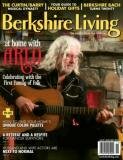
LIT FOR LIVING: The Middle Ages

Along with providing a guilty summer-reading pleasure, How It Ended, a book of new and old short stories by Jay McInerney, offers an opportunity to review the quiet-of-late career of one of the better-known members of the original literary brat pack that also included Tama Janowitz, David Leavitt, and Bret Easton Ellis. Although he almost never uses this region as a backdrop, McInerney, as it turns out, spent most of his formative, bratty years in the Berkshires, first in Pittsfield, Massachusetts, and then up the road at Williams College in Williamstown, where he met his now almost equally famous future editor, Gary Fisketjon.
With many publishing houses consolidating or closing, it’s hard to imagine a time when first-time novelists were treated like budding rock stars, but in the go-go early eighties, six-figure advances on novels barely completed by writers emerging from MFA programs were not uncommon. While such decisions rarely turned out to be sound business, Bright Lights, Big City, a slender novel published in 1984 by Vintage Contemporaries, a new paperback imprint run by Fisketjon at Alfred A. Knopf, was one of the exceptions. At fewer than two hundred pages, employing a second-person narrative device that McInerney somehow managed to sustain throughout, it felt at the time almost like a reinvention of the form—certainly a hip, fresh, counterculture voice that made a splash with twenty-something readers, in part because it could be gulped down in practically one sitting.
Literary lore has it that this all began quite haphazardly, with McInerney submitting one of his short stories to the Paris Review; McInerney then got a call from the editor George Plimpton himself, who said he was inclined to publish the story he had in hand, but wondered if McInerney had anything else around to show him. After the young writer became convinced that this was indeed Plimpton on the phone and not a friend playing a prank, he re-read everything he’d written (most of it at Syracuse University under the tutelage of Raymond Carver and Tobias Wolff) before reaching the deflating conclusion that the only non-derivative writing he’d done thus far was a scrawled handwritten note he found of something he’d started one morning after coming home from a club.
“You are not the kind of guy who would be at a place like this at this time of the morning. But here you are, and you cannot say that the terrain is entirely unfamiliar, although the details are a little fuzzy. You are at a nightclub talking to a girl with a shaved head.” McInerney immediately sat down and continued what became “It’s Six A.M. Do You Know Where You Are?” (which Plimpton did publish), and later, the opening of Bright Lights, Big City.

What followed Bright Lights, Big City, however, never quite lived up to the younger writer’s auspicious debut, critically or commercially. McInerney’s career might have paralleled that of F. Scott Fitzgerald (to whom he’s often been compared) if he’d followed up his first novel with a more mature, lasting work, as Fitzgerald did with The Great Gatsby after making an early splash with This Side of Paradise. While there have been other good works, most notably 1992’s Brightness Falls, the reception for McInerney’s last novel, The Good Life—a rather overly earnest post-9/11 tale—has become more the post-Bright Lights norm. Such a tepid reception may have led to a self-admitted writer’s block, which McInerney says he’s since overcome, partially through the discipline of sitting down and writing the twelve most recent stories that fill out this twenty-six-story volume.
Having been previously preoccupied with excess—drugs, sex, or conspicuous consumption—McInerney remains, with only a few exceptions, narrowly focused on sex and marriage (McInerney’s on his fourth, last count). And given their limited scope, fewer stories might have been decidedly more—as when visiting a large gathering of relatives, one starts to notice a familial resemblance soon enough. With that said, even McInerney’s more forgettable ones are never dull and would probably succeed if read on their own rather than in the context of a collection.
Men named Alex or Bryce or Russell in their mid-thirties to early forties living in New York, Los Angeles, or occasionally a transplanted New Yorker living temporarily somewhere in the South—as McInerney himself has done—married or seriously involved with a woman, cheat on wives or girlfriends and eventually must pay the price. Often there is a baby-to-be in the equation, as in wife or girlfriend is barely pregnant or wants to become pregnant. In “Getting In Touch With Lonnie,” one of these men muses,
He knows Laura wants children—and he does, too…. But even now, another world is calling out to Jared from beyond the stone walls and shaded lanes. From down the railroad tracks, south across the river, he can almost hear the buzz that begins anew every night—the brassy clatter of silverware and female voices busy with praise.
And yet what saves many of these efforts, and, in fact, raises some of the better stories to the level of, say, John Updike, Ann Beattie, Richard Ford, or even Fitzgerald or Hemingway (yet another influence), is that McInerney’s characters are far less cynical than their lives and actions might lead one to believe. He has no desire, for instance, to practice the kind of detached and more-than-occasionally mean-spirited satire of Tom Wolfe, who writes about much the same crowd, nor is he interested in going the fabulist route of John Cheever or Bernard Malamud. Instead, he takes these people quite seriously and believes that, warts and all, they are more than worthy of our time, attention, and even empathy.
In “Sleeping With Pigs,” it’s a pet pig that comes between a marriage, quite literally, as the pig (smarter and cleaner than most dogs, the woman in the story argues), is invited into the couple’s bed. But what begins as a Philip Roth- or Saul Bellow- or even Woody Allen-style comedy morphs into a much more serious and somewhat touching tale of a divorced couple still finding ways to comfort each other by way of a post-marital friendship. Just as pigs become stand-ins for children never born, ex-husbands often play the role of the husbands they might have been, but never quite are.
Kissing the back of her wrist, I could smell the sweet, milky, barnyard tang of her fingers. As I squeezed her hand and pressed her fingertips to my lips, I believed there was still time and hope for me, if I could only remember always exactly how I felt at that moment.
And, yet, if there is one recurring theme that sounds louder than all others, it’s that hope (especially when it comes to romantic love) springs eternal. These men may fail, colossally and repeatedly and sometimes comically, at romantic relationships—not to mention at parenting (though most don’t make it that far), but it’s not from lack of trying, or wanting.
McInerney, as it turns out, is every bit the romantic Fitzgerald once was; he wants us to feel as sorrowful as his characters genuinely do when they find out that life might not be as bright and promising as they once thought, when they realize that they’ll never quite become those better selves they once felt so sure they would become. They (and we) are most human, after all. And yet he seems also to want to suggest that there is still time to chase down those better selves, that all these lesser selves are entitled to their second acts, just as McInerney is certainly entitled to his. (JULY 2009)
Chris Newbound once attended a memorable reading when the author himself read the much-funnier-when-hearing-it-out-loud opening to Bright Lights, Big City.
THE GOODS
How It Ended
By Jay McInerney
Alfred A. Knopf
www.aaknopf.com

 Delicious
Delicious Digg
Digg StumbleUpon
StumbleUpon Propeller
Propeller Reddit
Reddit Magnoliacom
Magnoliacom Newsvine
Newsvine Technorati
Technorati


